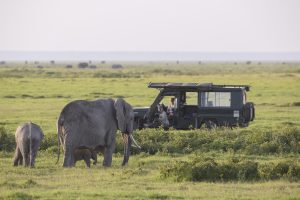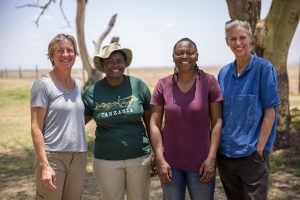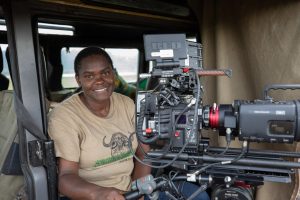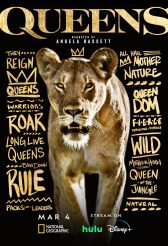
Cinematographer and mentee Erin Ranney films elephants on the RED Gemini and Canon CN20 in QUEENS | ©2024 National Geographic / Oscar Dewhurst
QUEENS is National Geographic Channel’s seven-part nature documentary series, premiering with three episodes on Monday, March 4, then running the other four episodes on Monday, March 11. The series is also available on Disney+.
Shot across six continents, QUEENS not only focuses on animal matriarchies, from elephants to ants, but was made by a women-led team of filmmakers and technicians, and narrated by Angela Bassett.
Director of photography Justine Evans, whose previous credits include PLANET EARTH and GREAT MIGRATIONS, and cinematographer Erin Ranney, who filmed on NATURE, sit down to talk about their work on QUEENS. This conversation took place during National Geographic Channel’s portion of the Winter 2024 Television Critics Association (TCA) press tour in Pasadena, California.
Evans says that how many cinematographers were involved in a particular sequence “varied quite a bit, depending on the program, but there were a lot. I can’t tell you the exact numbers, I’m sorry. On Episode One, for example, the hyena and lion story, there were a lot, because there was a lot of tech involved, so [there were] people who specialized in the Shotover gyro-stabilized camera system, and then there was night filming, thermal cameras, and so it was people with different skill sets were brought in, and also, there was a lot of time required, a lot of trips required, to tease out the behavior.”
Exactly how the shots were obtained, and whether or not they were in proximity to the wildlife, Ranney relates, “completely depended on the animal and the environment that we were in. So, for elephants, we were in cars, we’d drive around, long lens, or you’d have a gyro-stabilized gimbal, like Justine was talking about. [Filming] bears, we were on foot, so we’d walk, hike our bags in, get set up with the bears, and stay with them all day. [With the chimpanzee-like] bonobos, they hiked into the jungle and up on tree stands. It really depended on the animal.”

QUEENS Director of Photography Justine Evans, Mentee and Filmmaker Erica Rugabandana, Series Director and Mentee Faith Musembi, and Director of Photography Sophie Darlington | ©2024 National Geographic for Disney / Andrew Thompson
One episode, “Tiny Jungle Queens,” focuses on ants and insects. This, Evans explains, called for a novel approach. “Filming the leafcutter ants required another amazing set of technology. There was a motion-control system, which was this huge kind of arm on rails that was computer-programmable to make moves that you could save and repeat, and then the camera being able to go at low level, doing these micro movements, so you’re following an ant, from an ant’s point of view. I actually was climbing there and went up to film in the tree canopy, but on a normal camera system, just doing long lens. But long lens, you normally think of filming elephants or lions, and I was filming these tiny ants on leaves in the tops of the – like forty meters up,” she laughs. “So, yeah, it was a lot of different skill sets required for that.”
How detailed are the instructions provided to the cinematographers by the producers and showrunners? Do they specify what sort of behavior they want to see, or do they just ask for a footage of a particular species?
“When they’re sending you in the field,” Ranney replies, “they have kind of a storyboard of what they’d like to see, but obviously, animals don’t listen to any of it, so you have these things happen in the field. An example would be when we had the bears, our mom [bear] ended up getting hurt. They couldn’t have guessed that that would happen, but you have to adapt in the field, and you do have either an assistant producer or a producer in the field with you, who’s adapting the story as you go. So, you start with somewhat of an idea of what you’d like to film, but at the end of the day, the animals are the ones that are going to call the shots, so you end up adapting to it.”
Evans agrees. “You normally have an outline of a story, but as Erin says, if you see something really fascinating going on, then it’s like, ‘Right, okay, this is changing the story a bit, so how do we embrace this, and make sure we get all the shots we need around that to make it work?’”
Ranney adds, “It’s an incredible amount of teamwork, which I really love. You’re working together to figure out how to change the story with what’s happening.”

QUEENS Mentee and Filmmaker Erica Rugabandana | ©2024 National Geographic for Disney / Millie Marsden
Evans relates there were “loads of things” that she and Ranney found fascinating. “Filming Ethiopian wolves – that was an unexpected thing that happened, that the daughter [of the pack leader] that had left the pack, which is what they do, tried to come back, and it was just extraordinary to see her mum, who had brought her up from a pup and loved her, and was then going, ‘No,’ pushing her out, and then all the others were on her, saying, ‘No, you can’t, you’ve got to go.’ I found that fascinating, seeing that story unfold.”
Ranney, who had previously mostly worked in Alaska, says, “It was my first time in Africa, filming elephants, so every single thing I saw was new, and seeing how the matriarchy works together, how there’s this leader, how when she stops and she talks, everyone listens [was fascinating]. It was just so many things that I’d never had the experience to film yet right in front of me, and I think for me it was all very exciting.
Asked if they see any resemblance between the animal behavior they document and human behavior, both women laugh. “Oh, yeah,” Evans affirms. “You find out a lot with animals. I suppose you think, ‘Am I being anthropomorphic here, and trying to sort of slot human society notions into this animal world?’ But I think there are loads of crossovers. And especially with elephants … So many times, filming elephants, not just on QUEENS, but other times, I’ve just really related – ‘Yeah, I know that’s frustrating. Yeah, he’s being a little brat.’”
She gestures that Ranney should elaborate. “We were on birth watch for the pregnant elephants, we were following this pregnant elephant around, and she’d get really annoyed, and she’d just give her older daughter a whack with her trunk, and I was like, ‘Pregnant elephant, I don’t blame you. Your daughter is being a little irritating right now.’ I have friends who at the time were pregnant, and I was like, ‘I can see that’,” Ranney laughs.
Follow us on Twitter at ASSIGNMENT X
Like us on Facebook at ASSIGNMENT X
Article Source: Assignment X
Article: QUEENS: Cinematographers Justine Evans and Erin Ranney on their new National Geographic miniseries
Related Posts:











